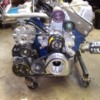These questions have probably been asked before, sorry for the redundancy. I don't have easy access to my car at this time.
What are the largest diameter coolant tubes that can be squeezed through the stock grommets? What size are the holes is the chassis for the coolant tube grommets?
Thanks for the help.
Mike
Original Post



